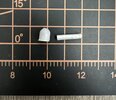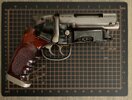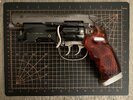I used Hycote standard grey acrylic primer for all the parts (including the hardware for the receiver since I wanted that to be a darker steel than the standard stainless steel of the bolts and screws).
I did three light coats of primer, wet sanding between each one with finer and finer Micro Mesh pads. After the final coat the parts were given a polish with a lint free cloth and then left to cure for a couple of days. Note the extremely professional painting/drying set up I have in my 'shop' (upstairs room)!
 View attachment 1505081
View attachment 1505081
Once all the parts were fully cured they were ready for paint. I had decided on Alclad II metallic laquers for the final finish. I knew I wnanted this gun to be fairly pristine, as it would have been on set, so the finish needed to be as perfect as I could make it. After much experimenting with different metallics in the past, and several horrible disasters along the way, Alclad are paints I've had success with before and they're a known quantity for me now, and I'm fairly confident in them. The colours I'd decided on were: 'Steel' for the receiver and bolt lever and the switch on the receiver side; 'Stainless Steel' for the Bulldog frame, cylinder, cylinder pin switch, weaver knob, inner grip frame, barrel, triggers, hammer, trigger guard and other parts; and 'Polished Aluminum' for the bolt itself and the butt plate. The shells would be 'Polished Brass' and 'Copper'. There's also a tiny brass accent on the left front magazine cover. The magazine and magazine cover would be satin black. And the rear covers would be gloss black. The outer grip frame, as far as can tell from photos, is matte black on the flat surfaces and gloss black on its back and front edges (of course with the signature wear at the bottom from the grinding of the butt plate.
The Polished Aluminum, Polished Brass and Stainless Steel need to have a gloss black basecoat. And the Steel and Copper need a matte or satin basecoat. So all the parts were basecoated in either gloss or satin black, depending on their final finish, again using Hycote rattlecans. Painting went well, with only a couple of minor runs to deal with (easily, with a quick wet sand and recoat) and I was really happy with the results.
View attachment 1505082 View attachment 1505083 View attachment 1505084 View attachment 1505085
The edges of the amber grips were wet sanded to give a nice flush edge, polished and then given a couple of coats of Rustoleum Crystal Clear.
View attachment 1505086
Again, once touch dry, the parts were all set aside to cure for a couple of days before starting assembly - the bit I was most looking forward to!




